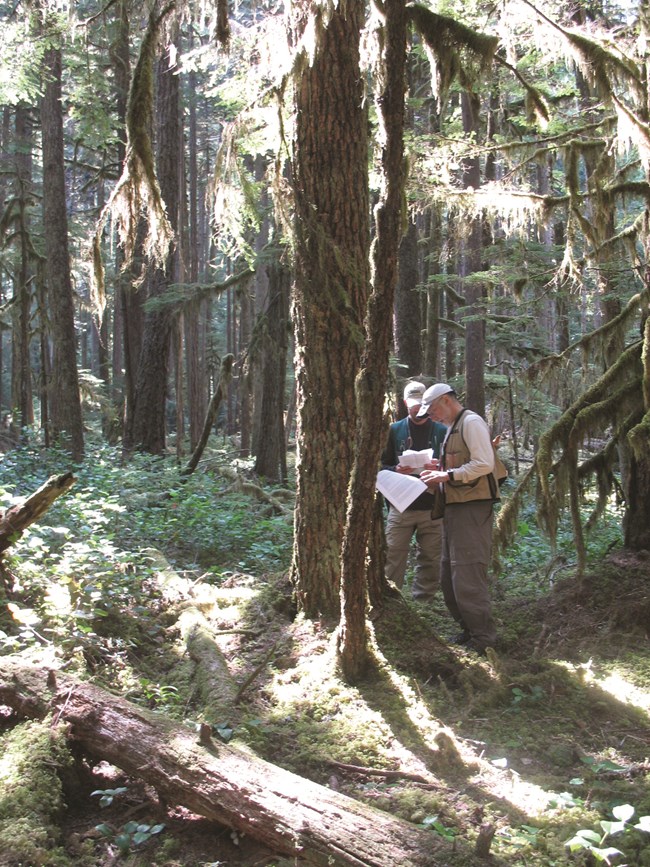
NPS Photo
Importance & Issues
Late-successional, coniferous forest is critical for ecosystem function and biological conservation in the Pacific Northwest. These forests store more carbon per area than most forests in the world. They are essential habitat for the region's biological diversity, including imperiled groups such as anadromous salmonids, spotted owls, and marbled murrelets. Such forests are well-represented in the North Coast and Cascades Network.
Climate change, air pollution, invasive species and other stressors threaten forest structure, species composition and abundance. This creates the possibility that these forests could turn from carbon sinks to carbon sources and threats the quality and quantity of habitat for terrestrial and aquatic species. In particular, climate change and air pollution are expected to be the greatest threats to national parks in the Pacific Northwest.
Tree recruitment, growth, and mortality are sensitive indicators of ecological change that can only be documented and understood through detailed, long-term observations. Increases in tree mortality have recently been reported for western North America, demonstrating the utility of long-term forest monitoring.
* Forest Monitoring is intermittent due to funding limitations
Monitoring Objectives
- Structure and Composition
- Trees — we monitor dimensions, canopy cover, indicators of health, and indicators of wildlife habitat by species to detect changes in the structural framework of forests upon which the other inhabitants depend. Wildlife habitat indicators link this protocol with wildlife monitoring protocols.
- Snags — we monitor changes in dimensions and degree of decay as indicators of forest structure and carbon cycling.
- Processes
- Tree recruitment — we monitor saplings to track changes in establishment success and species composition as indicators of changing forest structure.
- Tree growth — we monitor growth of tagged trees as an indicator of changing conditions for forests.
- Tree mortality — we monitor numbers of deaths annually by species to detect changes in rate and cause (if possible) as indicators of changing forest structure and composition.
- Environment (some of these are static and are only measured once)
- Landscape position of plot including slope, aspect, terrain position
- Soil properties (descriptive attributes such as texture and soil series)
- Physical characteristics (e.g., gap formation, water distribution on plot)
Basic Approach
The North Coast and Cascades Network forest monitoring program has established 45 plots at Mount Rainier, North Cascades, and Olympic National Parks and at Lewis and Clark National Historical Park, at elevations from sea-level to 1,800 meters. Plots are one hectare in size at Mount Rainier, North Cascades, and Olympic National Parks, and 0.25 ha at Lewis and Clark National Historical Park. Plots established to date include 23 tree species, representing most of the diversity of species in the parks. Additional plots will be established at San Juan Island National Historical Park as funding becomes available.
The specific forest types selected capture the extremes and the middle of the temperature and precipitation gradients for forests in the network. Sitka spruce forests at Olympic and Lewis and Clark comprise the warm and wet end of the gradient. These forests are important winter feeding grounds for Roosevelt elk. Plots at San Juan Island will represent an extreme of warm and dry forests in western Washington (with Douglas-fir, madrone, and oceanspray among the dominant species). The cold and dry end of the gradient consists of subalpine fir forests at North Cascades and Mount Rainier. The middle of the gradient is represented by western hemlock with a salal and/or Oregon grape understory, measured at Mount Rainier, North Cascades, and Olympic. These forest types are common throughout the region, and monitoring results will provide benchmark information for managed forests.
Tree mortality is assessed annually, and tree recruitment and growth are recorded every five years. We made our first evaluation of trends in tree mortality in the fourth year of the project (2011). Most plots (over two-thirds) showed no consistent trend in tree mortality at that time. Trends in tree recruitment and growth will be reported after 15 years, and trends in stem densities, tree basal area, and biomass will be reported after 10 years.
Management Applications
The rate of tree mortality in old-growth forests in the Pacific Northwest has doubled every 17 years in recent decades, according to a recent study in the journal Science. The increase in tree death is probably due to regional warming and drought stress, which can predispose forests to abrupt dieback. Forest monitoring in North Coast and Cascades Network parks will provide an early warning of such trends and insight into the potential effects on carbon storage, forest structure and composition, and habitat for organisms associated with old-growth forests.
Reports, Documents, and Datasets
Source: NPS DataStore Saved Search 3696. To search for additional information, visit the NPS DataStore.
Source: NPS DataStore Saved Search 3695. To search for additional information, visit the NPS DataStore.
Source: NPS DataStore Saved Search 5835. To search for additional information, visit the NPS DataStore.
Last updated: July 16, 2025
